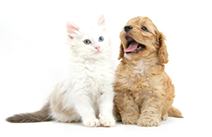Settling in your puppy
Settling your puppy into their new home is an exciting time for both you and your puppy, but it can be overwhelming.
Read this article for some helpful hints on how to help settle your puppy in, by establishing toileting routines, house rules and the right things to chew.
How to puppy-proof your home
Puppies and toddlers have some things in common, both can be destructive, be cheeky, and get into everything, but they can also bring you endless joy and comfort. That is why, because of these similarities, you need to puppy-proof your home, as you would child-proof your home. There are many things your puppy can get into that aren’t safe for them, or may land them in trouble.
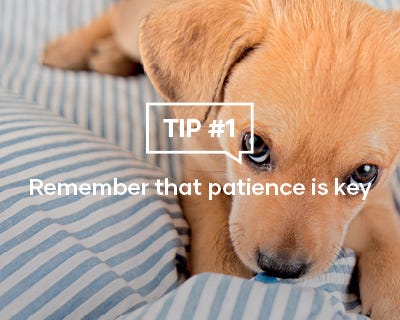 Puppies like to chew, and as they are young and still learning, they don’t always discriminate. Some puppies may like to chew the drywall, while others may keenly eye your new pair of leather shoes. Providing them with a puppy-proofed home, along with adequate and varied toys (this is covered in teething and mouthing later on in the article) helps your home and your property stay intact.
Puppies like to chew, and as they are young and still learning, they don’t always discriminate. Some puppies may like to chew the drywall, while others may keenly eye your new pair of leather shoes. Providing them with a puppy-proofed home, along with adequate and varied toys (this is covered in teething and mouthing later on in the article) helps your home and your property stay intact.
The first thing to check for is anything that your puppy may chew; think books, shoes, chair legs – if it’s within reach, chances are your puppy will try it out. Obviously, every area of your home cannot be off limits to your puppy, but ensure they have a safe area. While your puppy is exploring they will need to be supervised to keep them safe and to watch for any missed items.
Make sure you keep chemicals safely out of reach; it may only take a moment for your puppy to get into them. Any toys (including cat and children’s toys) that your puppy may swallow aren’t puppy-safe. Also, keep an eye on your puppy as they play with their toys, and throw out any bits they chew off their toy, or throw out the toy itself if it is worn or falling apart.
If you have a cat door, or a door to the outside, think about if you need to have a barrier for your puppy. A small breed puppy can easily fit through a cat door, or your puppy may be pushy and determined to squeeze through an opened door. Microchip cat doors are of great use here, as they will only open for programmed microchips, so you can let your cat out but the puppy won’t be able to use it.
A fully-fenced or secured section is recommended. This will not only provide a secondary line of defence if your puppy manages to get out through a door, but it will also protect them from running onto the road, or other dangers from coming in. If you do not have a fully-fenced area, look into other options, such as exercise pens or runs, but keep in mind these may not be suitable options to keep your puppy in permanently.
Things to consider:
- Do you have a room or area that you can puppy proof?
- You must be prepared to monitor your puppy when they’re exploring your home?
- Do you have a way to barrier any cat doors or doors? Is your property fully-fenced?
Introducing your puppy to the family
Bringing home your puppy is exciting for everyone involved, but making sure introductions are done right is vital to set up a robust relationship. Whilst every family member will play an integral part in your puppy’s upbringing, guaranteeing there is one person who is the main carer will give your puppy a solid foundation of trust to build from.
When a child is meeting your puppy ensure there is always an adult present. Have the child stand calmly with their arms by their side and let your puppy approach the child on their own terms, with a little bit of encouragement if needed. Once your puppy greets them, ask the child to pet your puppy on their chest (remember to avoid the head as some pups can find this threatening) and then give your puppy a treat and verbal praise. The child can also drop a treat for the puppy if they’re unsure. Praising your puppy for their good behaviours will help you on the path to a happy and well-balanced puppy.
Any adults that your puppy meets will either need to go down to your puppy’s level and offer their hand to the puppy or stand with their hand in front of them for the puppy to sniff. As dogs main sensory input is through scent, they gain as much as they can about a person through smelling them. Once your puppy has smelled the person’s hand, provided your puppy is confident, the new person may reward your puppy with a treat and verbal praise or even a pet on the chest. Remember that when anyone meets a puppy or dog for the first time, they should try a gentle approach and take your time with your puppy.
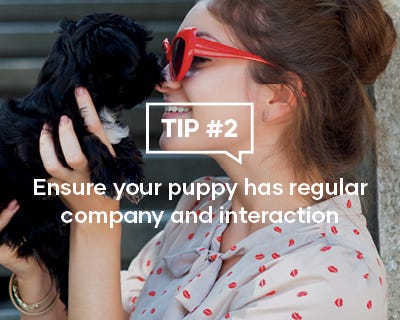 Once your puppy is comfortable with their new friends and family, make sure everyone spends time with the puppy. Try not to make too much noise or make too many quick movements as these may startle your puppy, or get them overexcited.
Once your puppy is comfortable with their new friends and family, make sure everyone spends time with the puppy. Try not to make too much noise or make too many quick movements as these may startle your puppy, or get them overexcited.
When introducing your puppy to any other pets, remember that patience is key. If you’re introducing your puppy to an existing dog, ensure you walk your existing dog so they won’t be as energetic and intimidating to your puppy.
When introducing the puppy to your dog, have your dog sitting calmly in a position they’re comfortable with, and have your puppy on a lead. A puppy can be an intrusive so introduce slowly and allow your adult dog to lead the interaction. Always give both dogs an escape route, so if they are becoming overwhelmed or have decided they have had enough they can get away. It is your responsibility to watch the interaction and make sure it is comfortable for both pets. Reward with pats, verbal rewards or a treat for any positive interaction, such as your dog sniffing the puppy, or your puppy sitting calmly while your dog walks past. Both dogs need to have their space while they get used to each other, so do not encourage sharing of treats.
While your puppy is still young it is imperative that you do not leave other dogs unattended with your puppy, as all introductions at this age will need to be calm to promote a neutral friendship. Even if they look like friends, your puppy has likely left an environment where they had littermates or other puppies to play with, and although your adult dog just looks like a bigger version, they can be much less tolerant.
When introducing your puppy to other animals, it’s important that you keep all other animals safe. Puppies can be bouncy, hyperactive and very intrusive to other animals, especially novel ones that they may not have met before.
Introducing your puppy to your cat
When introducing your puppy to your cat, let your cat watch your puppy. Reward your cat with treats, so they recognise that the puppy is a good thing and make sure the cat has high places to feel safe away from the reach of the puppy.
Ensuring your puppy has good behaviour while meeting the cat will help your cat feel more comfortable. Have your puppy sit, and reward them. When they see the cat, reward them, it’s important that your puppy knows that acting calm around your cat is the behaviour you want and is all that will be rewarded. Supervision, persistence and rewarding any positive behaviours will help your pets learn to live together. Some cats may never truly warm to a dog but they can learn to respect each other. In this situation, you are responsible to guarantee both of your pets are well-cared for and safe.
Introducing your puppy to other pets
Take the time while your puppy is young to introduce them to other pets as well. Rabbits, birds, mice and rats are some of the pets that your puppy could encounter through their life and ones they should be accustomed to seeing, and ignoring. Keep any interactions short and positive, with lots of rewards for your puppy when they ignore the other pet. Training your puppy to focus on you in new events, so they look to you for guidance will help, as will spending time training your puppy to learn the ‘leave it’ command (read our Training article).
to learn more). Both of these techniques will remind your puppy of the right manners when meeting small pets and aid you in growing a stable relationship between your puppy and other pets.
Keep in mind your puppy, and other pets, each has natural instincts. What this means is that some puppies will not be friends with other pets, and some other pets will never truly warm to a puppy. This is okay. Ensuring your puppy, cat, and other pets each have their own space and that your cat and other pets have areas that your puppy cannot get to. Remember adult supervision may always be necessary.
Things to consider:
- Decide who your puppy’s main carer will be
- Do you have plans in place to introduce your pets to each other?
- Don’t expect too much. Bonding pets will take time
- Ensure all pets are safe and have their own areas that they can trust
- How will your cat handle a new family member?
- Be patient. Patience is the key to ensuring all family members bond well
Your puppy’s first week at home
What to expect
This is going to be a challenging first week for your puppy, it will most likely be their first week away from their mum and littermates, so they will be feeling lonely and unsure of their place. Ensure your puppy has company and interaction and include them in your day-to-day life. If your puppy is home alone during the day we recommend having someone pop home during lunch to interact with your puppy and to toilet them, so they are not suddenly left alone for long periods of time. As a guideline, up until three months old, it is recommended that small breed puppies are fed four times a day, and any medium-large breeds three times a day but again this is just a guideline and your vet is the best person to guide you on the nutritional needs of your puppy. Beginning routines for them from day one is important as it will set them up to succeed with fitting into your family life.
When they wake up, take them toilet immediately and then incorporate them in your morning routine, including feeding them breakfast and spending some time playing with them. Allow for plenty of napping times for your growing pup during the day, it’s a great opportunity to work on crate training, or to have a break yourself.
Walk your puppy around your property (if they’re not fully vaccinated) and use this time to get them used to being on a lead. Spend time with your puppy, begin training and make sure all your family members have a hand in raising your new puppy, as it’s important everyone in the household raises and reinforces behaviours in a consistent way to help cement this information.
At bedtime, take your puppy toilet first. A handy tip to help prevent toileting mid-way through the night is to follow a small bedtime checklist:
- Quiet behaviour (not excited playing)
- Ensure they’ve eaten a couple of hours before bed
- Toilet them before bed
- Remove the water at least two hours before bed
At bedtime, ensure they are well settled, and (if appropriate for your puppy) have a cuddle buddy toy to snuggle up to. We recommend crate training to give your pup a bedroom of their own and to keep them safe overnight. Sleeping alone is a lot to get used to for a young puppy. While whining is not ideal, your puppy may be stressed and unhappy. Make sure their basic needs are tended to (e.g. toileted, full bellies, and warm) and make sure to check on them if they’re distressed and take them to the toilet, their little bladders can only hold on for so long. There may be whining during the night and we suggest getting up once to check your puppy, take them to the toilet and to settle them back in. Pretty soon you should be able to learn the difference between a whinge for toilet vs a whine for attention.
Toilet training
Toilet training is one of the most important things to get right for all puppy owners. Identify the area that you want your puppy to toilet indefinitely, it could be outside near the deck, on the front lawn or on a piece of fake lawn on your apartment balcony. That will have become the place where you take your puppy toilet. After every meal, drink, playtime or naptime, you need to take your puppy to their designated toilet area. Remember that each puppy is different and that as they grow the amount of time they can hold their bladder will lengthen, but it’s important to start the training while they’re still young so the two can work in conjunction. Doing this on the lead will help to make sure your puppy stays in the correct area. Take this time, while they are learning to the toilet where you want them to and on lead, to introduce your puppy to new texture and surfaces for them to the toilet on. If they always toilet on the grass at your house, take them for a walk on the beach or on a dirt track and encourage them to the toilet there – this will help to make sure your puppy doesn’t avoid going to the toilet on surfaces they haven’t used before.
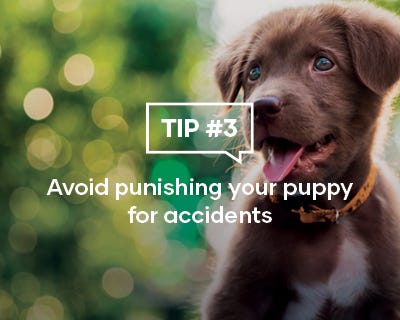 If your puppy is trying to play, ignore them and keep walking around until they focus on sniffing the ground, or look like they are going to the toilet. Pick your puppy’s word for toilet, it could be ‘go busy,’ ‘toilet,’ ‘pee pee,’ ‘tinkle time,’ or a variation you’re comfortable with. Every time your puppy begins to go toilet say their keyword e.g. ‘go busy,’ and when they’re done, make a fuss and offer a reward of a treat. This will begin the association with your dog with ‘go busy,’ and toileting as being a positive thing and rewarding them.
If your puppy is trying to play, ignore them and keep walking around until they focus on sniffing the ground, or look like they are going to the toilet. Pick your puppy’s word for toilet, it could be ‘go busy,’ ‘toilet,’ ‘pee pee,’ ‘tinkle time,’ or a variation you’re comfortable with. Every time your puppy begins to go toilet say their keyword e.g. ‘go busy,’ and when they’re done, make a fuss and offer a reward of a treat. This will begin the association with your dog with ‘go busy,’ and toileting as being a positive thing and rewarding them.
Accidents will eventually happen so avoid punishing your puppy for getting it wrong. The key is to clean up and move on. You don’t want your puppy to be scared of you, especially when it comes to toileting behaviour as this may lead to your puppy to toileting in secret areas (behind the sofa, under the table) and is detrimental to their toilet training as a whole. Ensure you are constantly observing your puppy and their behaviour as they will begin to show signs (suddenly stopping play, sniffing around, going to the door or trying to hide somewhere) you recognise as meaning they need to toilet, and that’s your cue to take them outside. Toileting training your puppy, is also about training you, as our puppies rely on us to show them the right place to go, and to reinforce their good behaviours.
Crate training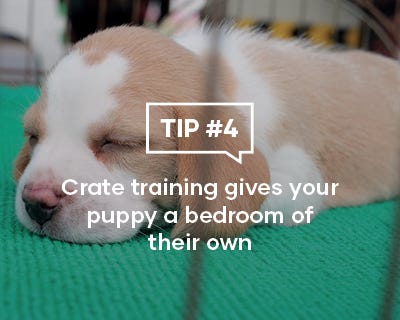 Crates are a fantastic toilet training tool that is widely recognised and used for puppies (and dogs). The premise behind crates is that they create a safe ‘den’ for your puppy while you cannot watch over them, or if they’re particularly tired and want a comfortable place to sleep. The crate should never be used for punishment, it’s their own bedroom and in the future, they may even take themselves to bed in their own crate when they’re tired.
Crates are a fantastic toilet training tool that is widely recognised and used for puppies (and dogs). The premise behind crates is that they create a safe ‘den’ for your puppy while you cannot watch over them, or if they’re particularly tired and want a comfortable place to sleep. The crate should never be used for punishment, it’s their own bedroom and in the future, they may even take themselves to bed in their own crate when they’re tired.
If you are not home, or are busy cooking in the kitchen, or cleaning the bathroom and can’t attend to your puppy, simply pop them into their crate with a few favourite puppy-approved toys and let them settle in. It’s important to pick the right location when conditioning your puppy to recognise the crate as their safe space. The crate is best put in a communal area so your puppy is not isolated from their family. Remember that dogs are social animals, and do best when they’re included as part of the family. Crate training can aid in preventing accidents, and it helps teach your puppy bladder control but remember as their bladder is developing they cannot be left for long periods.
There’s lots more to cover in regards to crate training, which you can read here.
Teething and Mouthing
Puppies will explore with their mouths and will go through a key teething period. It’s important that your puppy has a variety of teething toys to support this period, and all family members are aware to not let the puppy teethe or mouth their hands. Instead, the best thing you can do is offer your puppy teething appropriate toys. There are plenty available such as puppy teething keys, a puppy Kong, or a Nylabone. All of these are softer toys, as toys that are too hard can hurt sore teeth.
When your puppy begins to mouth you, redirect their attention onto that of an appropriate toy, and verbally praise them. Do this each time your puppy tries to chew you and though it may seem repetitive, the association will start to become clear to your puppy. You may need to play and get your puppy excited about the new toy to stop them from going back to the original item. Be patient and use plenty of verbal praise when they choose the right thing to chew on.
Things to consider:
- Is someone able to come home at lunch to see the puppy?
- Have you thought about your puppy’s daily routine and how to fit it in with yours?
- Where do you want your puppy to the toilet?
- What phrase will you use for your puppy to go toilet?
- Have you thought about crate training?
- Where will you put the crate?
Child safety
 Keeping both children and your puppy safe during all interactions is important in building a lasting bond for your puppy, your family and you. Children and puppies can both be unpredictable. Ensure you always supervise any interactions between children and your puppy, and explain the importance to your child of staying calm around your puppy. If your children do get too excited, your puppy could become just as excited, if not more.
Keeping both children and your puppy safe during all interactions is important in building a lasting bond for your puppy, your family and you. Children and puppies can both be unpredictable. Ensure you always supervise any interactions between children and your puppy, and explain the importance to your child of staying calm around your puppy. If your children do get too excited, your puppy could become just as excited, if not more.
Anytime your child is approaching your puppy, have them offer their hand to your pup so they can sniff their hand and ‘get to know’ your child this way. Make sure that any interaction is positive. This means, only let your child play with your puppy when your puppy isn’t too tired or too active. Don’t forget to teach your child how to properly give a treat to your puppy, and ensure they are able to reward your pup for any positive behaviours – manners are needed from both sides.
Overly excited play from children can easily startle or overexcite a puppy, so if play is getting too much, consider putting your pup away in their crate or into their bed or try swapping to a calmer play style. This isn’t punishing the puppy, but removing it from a situation where it may not know how to respond. If you’re ever unsure of a situation, the easiest thing is to remove your puppy from it. Children and dogs should always be supervised, so make sure you’re around for any play time. For more tips on socializing your puppy with new people, read our article here.
Things to consider:
- Always monitor children and puppies when together
- Discuss the importance of being calm and respectful around your puppy
- Teach your child the correct method of greeting dogs, and ensure they are comfortable to do this with your puppy
- Remove your puppy from any situation they may not be comfortable in
Your local council requirements
You must legally register your puppy by 3 months of age. Specific rules can apply to some local councils, so we suggest popping onto their website or giving them a call to determine what you need to do for your puppy.
Depending on your council’s restrictions you may need to apply for a permit if this means you will have more than one dog on your property, and all companion puppies and dogs must be microchipped. Discounts are offered for those puppies who are desexed, so keep that in mind when it comes time to desex your pet.
Once registered with the council, they will send out a tag that must be kept on your puppy at all times, in case they go missing or get lost and to identify them as a registered dog.
And once you have had your puppy for long enough (this varies depending on your region), there is also the ability to apply for an RDO license (Responsible Dog Owner), this is a special dog ownership status that recognises good, responsible dog owners and entitles them to a reduced annual dog registration fee.
Things to consider:
- Contact your local council to see what you need to do to register your puppy
- Is your puppy microchipped?
- Do you need a multiple dog permit?
- Responsible dog owner license
Key points to remember
Settling your puppy into the family takes time so to recap; here are the key points for a smooth introduction for your new family member.
- Ensure you have discussed who the main carer for your puppy will be and have an established routine in place as soon as you get your puppy to help with their training and settling in
- Don’t forget it is important to ‘puppy proof’ a safe area of your house while they settle in, and consider using a crate
- Pick the right area for your puppy to the toilet, it should be one that is easy to access at short notice but easy to clean helps
- Make sure you invest in some teething appropriate toys and begin to curb your puppy’s mouthing habits as soon as you can
- Keep in mind everything is new to your puppy; so take it one day at a time and introduce things slowly
Lastly, from all of us at Animates and Animates Vetcare, we hope you have a great time settling your puppy in, and feel free to pop in to your nearest Animates or Animates Vetcare clinic should you need any more advice.


